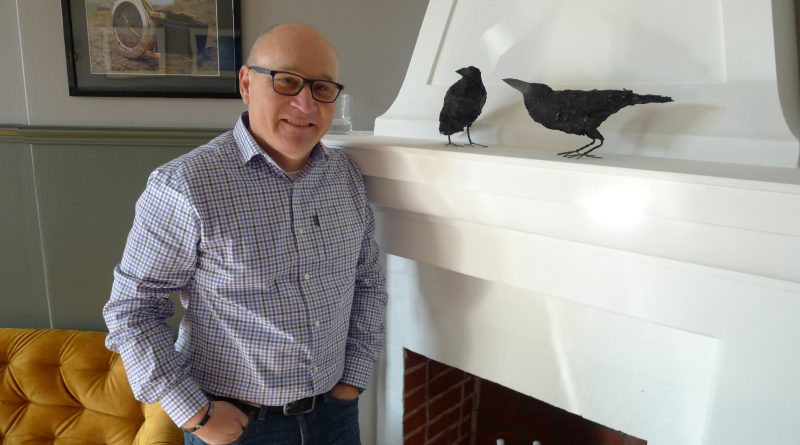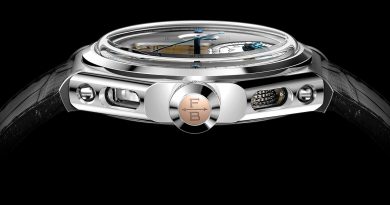A Tale of Nordic Craftsmanship
We have the extraordinary privilege of engaging in a conversation with the brilliant mind behind GoS Watches, Patrik Sjögren. The world of horology is a realm of precision and elegance, and Patrik’s journey into this world is nothing short of fascinating.
From the serene landscapes of Sweden, Patrik’s path has led him to become a true master of his craft. His dedication to watchmaking has resulted in timepieces that are not just instruments for tracking time but also exquisite works of art. The fusion of tradition and innovation is his hallmark, and his creations seamlessly intertwine traditional crafts, the heritage of watchmaking, and modern technology.
However, Patrik’s expertise extends beyond watchmaking; his designs are narratives, capturing the enchanting phenomena of the northern lights and the rugged beauty of Sweden’s landscapes. Each GoS watch is a unique canvas, offering a glimpse into the rich history and culture of this captivating country.
So, let’s embark on this conversation with Patrik Sjögren, as he imparts his insights, inspirations, and the remarkable journey that has brought GoS Watches to the forefront of horological artistry.
What drew you to the world of watches, and how did you first become passionate about them?
It was the passion for the handcraft itself and the prospect of working in metal that drew me into the watchmaker profession. But my passion for mechanical creations was born long before that. As a child, I enjoyed both playing with and repairing mechanical toys (yes I´m that old). I also spent a lot of time in my grandfather´s workshop where he used his ingenuity to repair just about anything. He was a self-taught mechanic and the go-to guy when a vital machine had stopped working and there were no replacements or spare parts.
There was a long time gap between my first encounters with mechanics to when I came back into watchmaking. During that time period, I studied computer science and started a career in Computer Security and Medical imaging with a Ms.Sc degree. However, I recalled the feelings of wonder I had as a child when entering a watch workshop as a child as soon as I stepped into the Swedish watchmaker school in Borensberg.

Can you share a memorable experience or story from your career that highlights the craftsmanship and dedication that goes into creating a watch?
I think the creation of the Väring Viking watch from 2018 is a good example as I wanted to make a watch in all Damascus steel and bronze to commemorate the return of a local Viking leader. I had no previous experience in making case parts but my engineering background gave me confidence to jump into the challenge. Once the prototype was ready for reveal, I had made all parts except for the dial and case rings myself from bronze. In the process, I had also developed a new finishing technique for the hands that I named Côtes de GoS, tounge-in-cheek. During the process, I also learned how to pre-patinate all parts to create the contrasts between surfaces that I always try to include in my creations. So, it was definitely a big step for me to introduce a watch where I had made so many parts as well as realizing the idea behind it.

In a world where smartphones tell time, what do you believe makes traditional timepieces still relevant and appealing to collectors and enthusiasts?
Timepieces express the owner’s sense of beauty and it has always been an indication of the bearer’s status. Watches from Independent watchmakers are rather an extension of the creator and his/hers creativity and artistic ambitions – so it is inherently more soulful than mass produced timepieces. Smartphones have nothing of that and that’s why you often see them embellished with personal cases.
Are there any behind-the-scenes details about watch production or design that people often overlook, but you find fascinating?
I knew early on that GoS would not be the only watch with parts in Damascus steel when we introduced the first watches 15 years ago, or 12 years ago with the Damascus steel case. However, while other brands that now use Damascus steel are pleased with just seeing a pattern in the material, I put a lot of effort in bringing out the three-dimensional aspects of pattern-welded steel. I still find it fascinating to see how the expression of e.g. a dial can change between finishing steps and I often re-do steps when I don’t see the expression I’m aiming for.


How do you balance tradition and innovation in the watch industry, and can you share an example of a watch that successfully accomplishes this?
For me, I always awe at brands that can be innovative while still being true to or extending traditions. One example of a brand that is successful in this balance is Armin Strom with both their Resonance pieces as well as their Gravity Equal Force.
As a professional in the watch industry, what’s the most challenging aspect of your work, and how do you overcome it?
There have been times where finances have been very difficult. As a small manufacturer without financial backing, almost every decision you make has some element of calculated risk. The decision to create a second edition of the Sarek collection instead of continuing with the existing model, despite it being asked for, was definitely a calculated risk. What you see in Sarek Frost is the combination of innumerable improvements as well as a dial with elements, which together took two years to develop from idea to prototype.
Could you tell us about a watch that you find truly iconic or significant, and explain what sets it apart in your eyes?
I´m not much into complications when they don’t bring something aesthetically pleasing to the table, like the tourbillon. One tourbillon watch that’s been a favourite of mine is the McGonigle tourbillon that combines exquisite finishing, elegant and extremely well balanced design elements and beautifully embellished case back.
When assessing a watch’s value, what factors do you consider, and what advice would you give to someone looking to invest in a timepiece?
This is really tricky as a watch inherits so much of its value from the brand itself. Personally, I always look for finishing and design coherence and I always prefer to see a human touch rather than machine-like perfect edges.

Can you tell us about a watch project or creation you’ve been involved in (your own or a collaboration) that you’re particularly proud of, and what sets it apart from other timepieces? This could be a project from the past or something in the pipeline.
This must be the Skadi watch where I collaborated with four other Swedish artisans to create a watch with a bold expression. I used skills I learned from the Väring watch when creating the case parts in gold but relied on the skills of an steel maker, engraver, gold smith, jewel setter to make the end result as good as possible. This watch also features another creation of mine, i.e. the coloured and luminous mother-of-pearl dial.


How has the watch industry evolved over the years, and what trends or changes do you anticipate in the future?
Both artistic and technical level have increased a lot over the 15 years I´ve been active with GoS. The number of talented watchmakers that are able to bring their creations to market is truly astonishing. When I started, there was AHCI (Académie Horlogère des Créateurs Indépendants) and then a few other independent watch brands with already strong expression. I believe that brands need to stay true to their core values and communicate that, instead of jumping onto what’s currently trendy.
Before we introduce your latest creation, one final question – on a more personal note, what is your favourite watch, and what does it mean to you?
The Sarek Frost is of course my current favourite watch, finally out in the open after many hurdles along the way. But another watch I cherish is the Breitling Cosmonaute (Ref: A22322) that I was gifted as a part of the Breitling scholarship I received when I finished my studies at the watchmaker school.


Introducing SAREK FROST


Design Rooted in Scandinavian History and Nature
Drawing inspiration from the rich tapestry of Scandinavian nature and history, GoS Watches stands out as a pioneer in the use of hand-forged pattern-welded steel, commonly known as Damascus steel. The brand’s journey began in 2008 with the introduction of the first watch featuring a dial and winding crown made of Damascus steel, followed by the unveiling of the first watch with a Damascus steel case in 2012.
The design process involves pushing the boundaries of watch design, incorporating traditional artisan handcraft techniques and innovative applications. Noteworthy is the Northern Lights collection, where transparent index rings made from hand-blown glass elevate the artistry of timekeeping.
Cottage Frost Window: A Nostalgic Inspiration


Patrik Sjögren’s early years in a weathered wooden cottage near Stockholm inspired the Sarek Frost. The frost-laden windows of his youth, adorned with delicate patterns, sparked the idea for a unique watch dial. Mirroring the randomness of frost and ice patterns, the dial captures the ephemeral beauty of those fleeting works of art, reminiscent of quiet nights and morning marvels.
Capturing Frost: The Unique Dial of Sarek Frost


The Sarek Frost’s dial, a testament to Patrik’s ingenuity, showcases a sunray finish in glossy transparent and matte white hues. The dial, a first for GoS, features a sapphire hour track formed of 12 sections, incorporating Swiss Super-LumiNova® in three-dimensional form. Customers can choose between Midnight Blue and Ice Blue, mirroring the appearance of frost in different light conditions.


The slightly smaller 41.5mm stainless steel case, reworked lugs, and optional stainless Damascus steel bezel reflect GoS’s commitment to craftsmanship. The caseback, engraved with a frost-themed pattern, mirrors the motif on the dial, creating a cohesive and visually striking timepiece.
A Symphony of Movement: The G101 Calibre
At the heart of the Sarek Frost beats the G101 Calibre, a self-winding Swiss movement personalized for GoS by Manufacture La Joux. The dark grey anthracite finish, along with a skeletonised oscillating mass, adds an exclusive touch to the movement. The dial, adorned with a random frost-themed pattern, is a masterpiece crafted with precision and care.

Limited Edition Frost: One out of 100
Due to the intricate production process, each dial variant of the Sarek Frost is limited to 50 pieces. Customers can choose a stainless-steel bezel or opt for a stainless Damascus steel alternative. Every watch is engraved with “Sarek Frost – One out of 100,” signifying its exclusivity and uniqueness in the world of timekeeping. Don’t miss your chance to own a piece of Nordic craftsmanship with the Sarek Frost.

Further information: https://www.goswatches.com/
All materials reproduced in good faith – copyright of their respective owners




